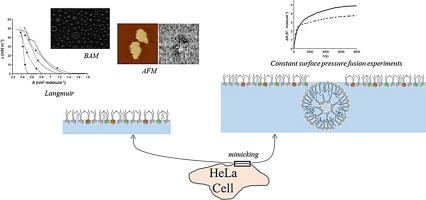Characterization of monolayers and liposomes that mimic lipid composition of HeLa cells.
In this work, based on several studies, we develop an artificial lipid membrane to mimic the HeLa cell membrane using 1-palmitoyl-2-oleoyl-sn-glycero-3-phosphatidylcholine (POPC), 1-palmitoyl-2-oleoyl-sn-glycero-3-phosphoethanolamine (POPE), 1-palmitoyl-2-oleoyl-sn-glycero-3-phospho-l-serine (POPS) and cholesterol (CHOL). This is then a means to further study the fusion process of specific engineered liposomes. To characterize the mimicked HeLa cell membrane, we determined a series of surface pressure-area (π-A) isotherms and the isothermal compression modulus was calculated together with the dipole moment normal to the plane of the monolayer. The existence of laterally segregated domains was assessed using a fluorescence technique (Laurdan) and two microscopy techniques: Brewster angle microscopy (BAM) and atomic force microscopy (AFM) of Langmuir-Blodgett films (LBs) extracted at 30 mN m-1. To examine the nature and composition of the observed domains, force spectroscopy (FS) based on AFM was applied to the LBs. Finally, two engineered liposome formulations were tested in a fusion assay against mimicked HeLa cell membrane LBs, showing good results and thereby opening the door to further assays and uses.


